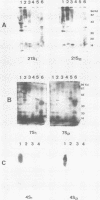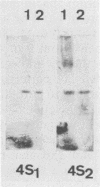Abstract
A bacterial agglutination assay, a toxin-neutralizing assay, and an enzyme-linked immunosorbent assay (ELISA) were used to compare antibodies against intestinal Aeromonas strains in serum samples from healthy carriers (n = 6), from patients with acute (n = 15) or chronic (n = 8) gastroenteritis, from patients with gastroenteritis caused by other enteropathogenic bacteria (n = 3), and from healthy blood donors (n = 50). Evaluation of the bacterial agglutination assay showed that it was not very useful. The sensitivity of the ELISA in patients with acute or chronic aeromonas-associated diarrhea was 30% (7 of 23 patients were positive), whereas the specificity was 74% (13 of 50 healthy donors were positive). Positive results in the ELISA correlated with immunoglobulin M and immunoglobulin G responses to lipopolysaccharides of homologous Aeromonas strains, as determined by gel immunoradioassay and Western immunoblot analysis. The sera showed cross-reactions with heterologous Aeromonas strains and with Escherichia coli strains. The toxin-neutralizing assay was positive in 5 of 11 patients who had developed acute severe diarrhea associated with cytotoxin-producing Aeromonas strains (46% sensitivity), whereas only 3 of 50 healthy donors had low serum titers of cytotoxin-neutralizing antibodies (94% specificity). All five patients were over 60 years of age. Cytotoxin-neutralizing activity was not observed in the sera of other groups of patients with aeromonads in their feces. We concluded that the three different serologic assays were not consonant with one another and that only the toxin-neutralizing assay distinguished patients with acute diarrhea from other groups of patients.
Full text
PDF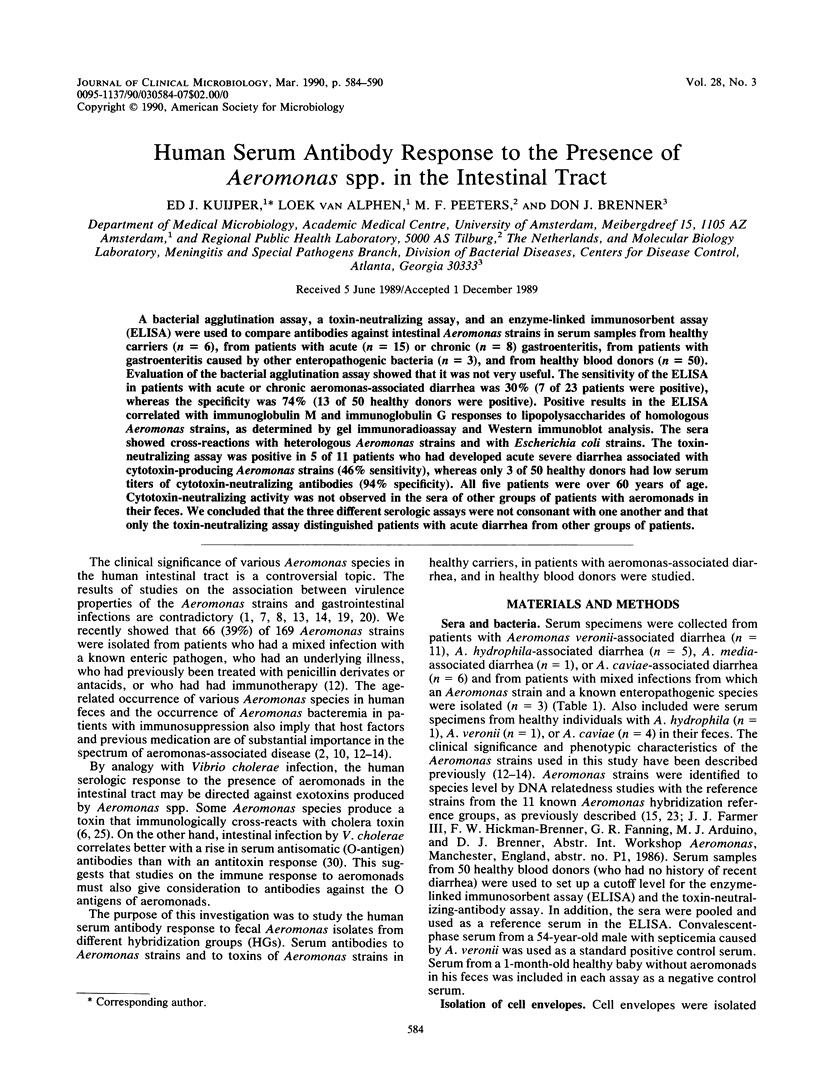
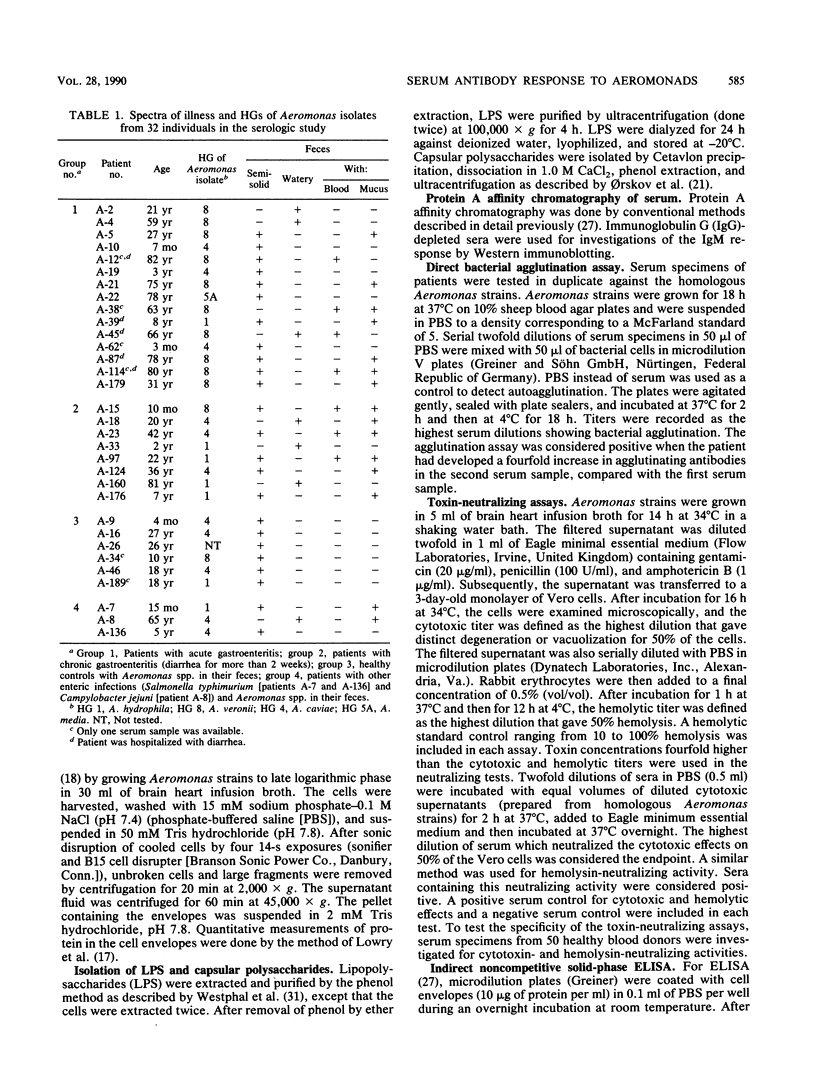
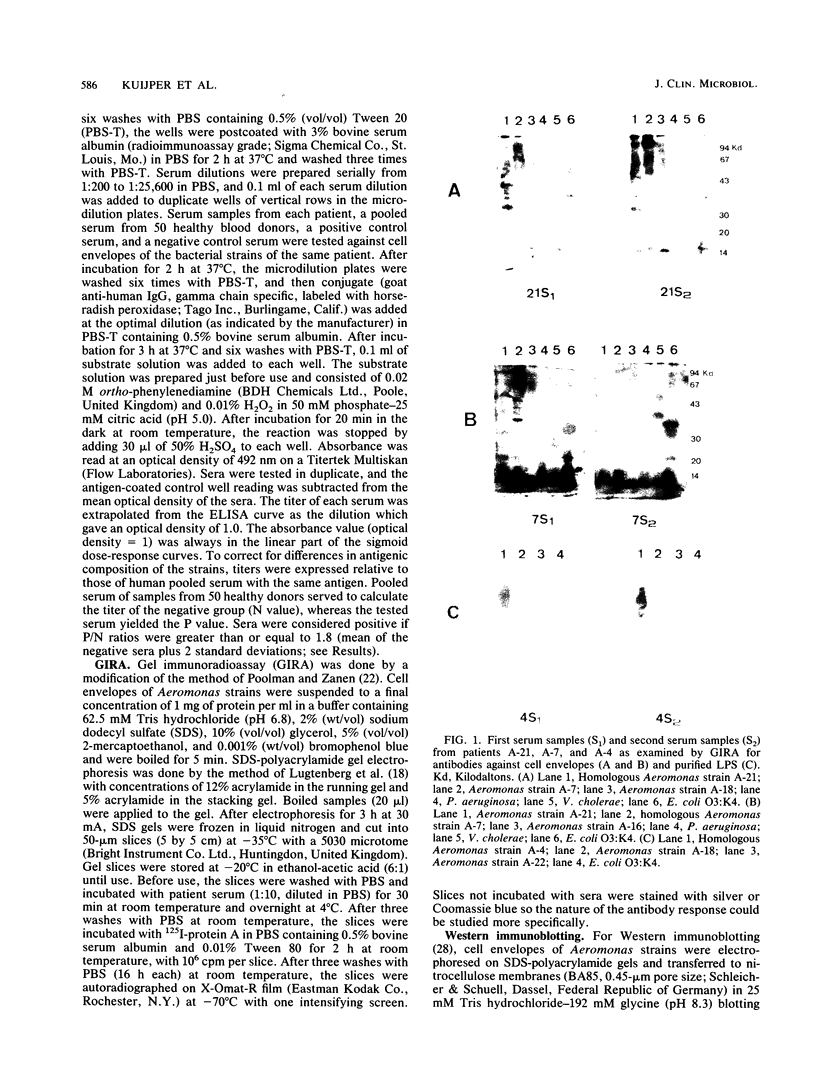
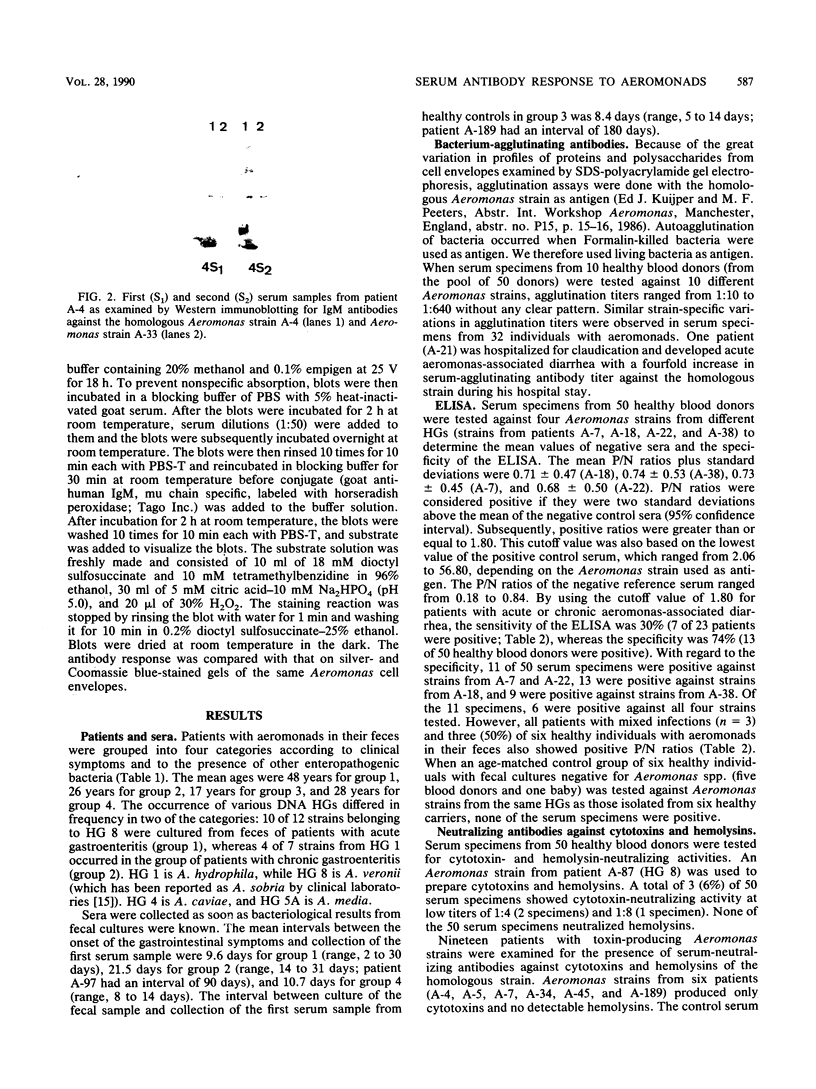
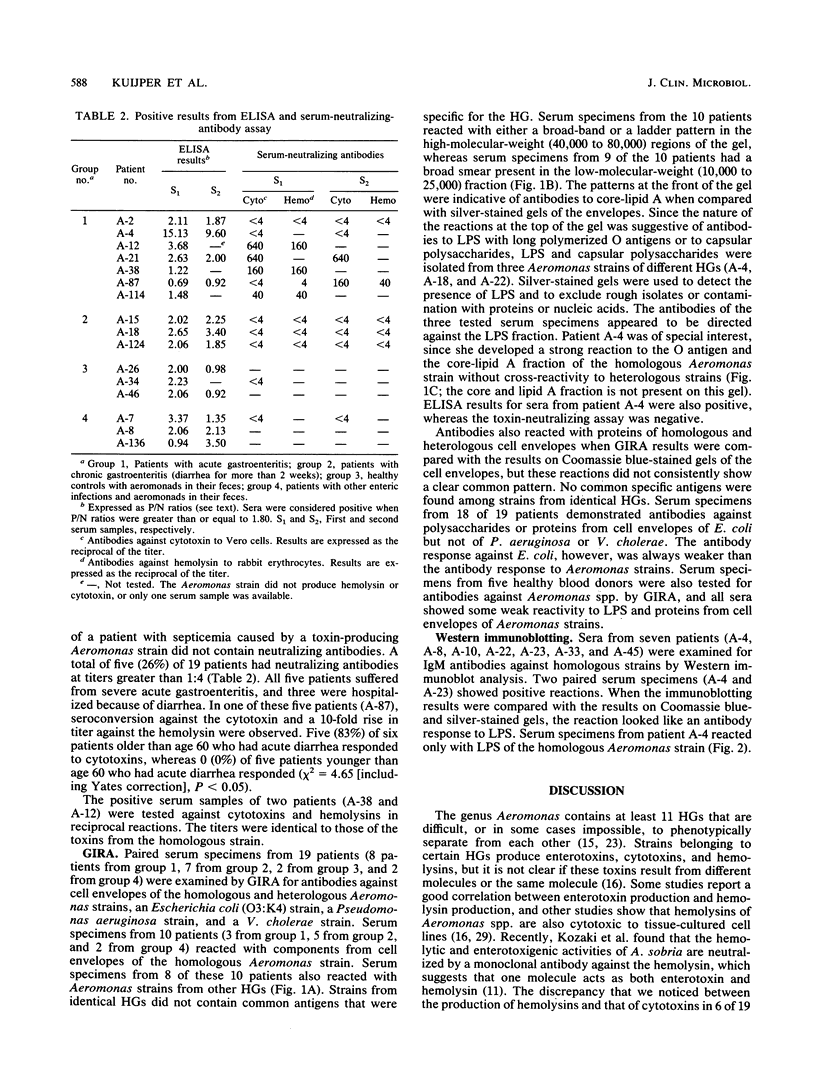
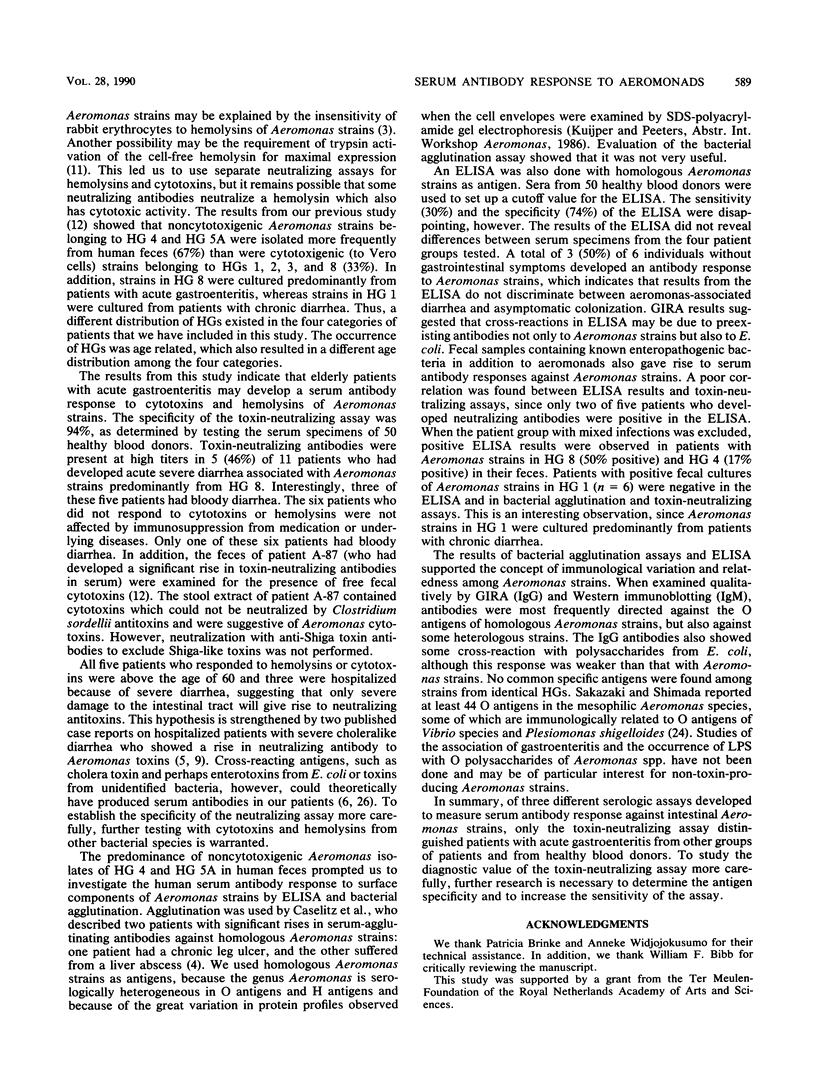
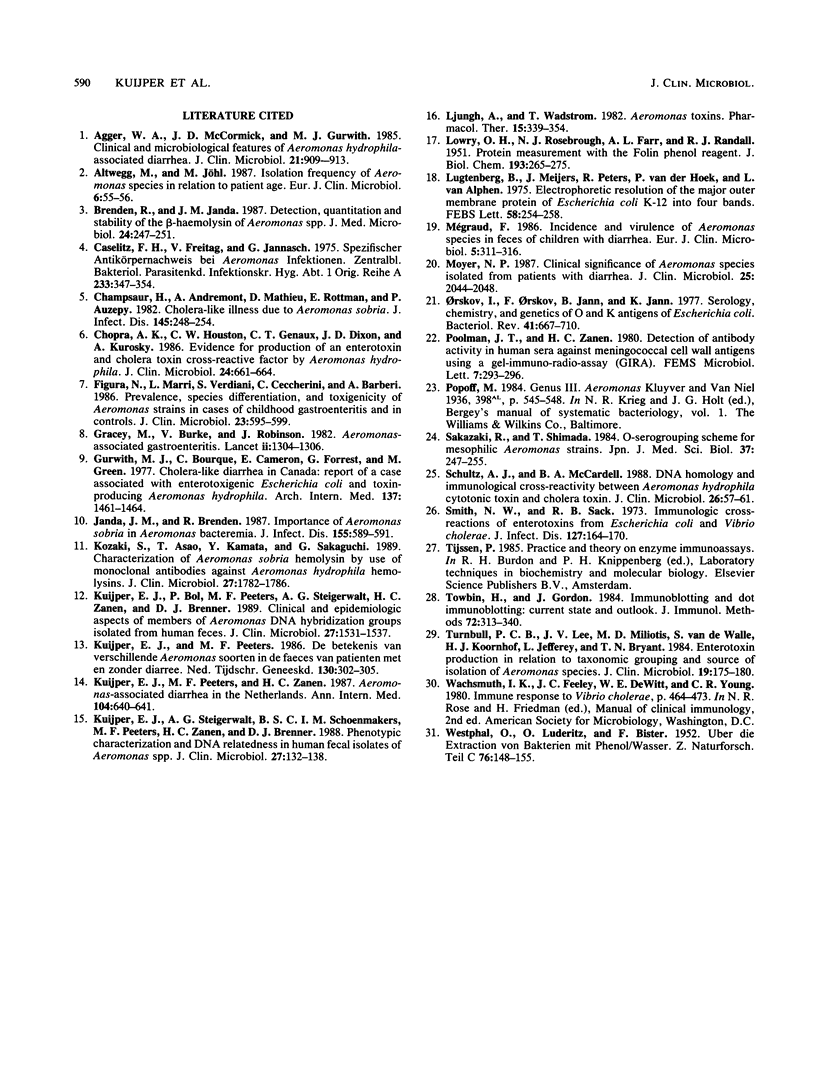
Images in this article
Selected References
These references are in PubMed. This may not be the complete list of references from this article.
- Agger W. A., McCormick J. D., Gurwith M. J. Clinical and microbiological features of Aeromonas hydrophila-associated diarrhea. J Clin Microbiol. 1985 Jun;21(6):909–913. doi: 10.1128/jcm.21.6.909-913.1985. [DOI] [PMC free article] [PubMed] [Google Scholar]
- Altwegg M., Jöhl M. Isolation frequency of Aeromonas species in relation to patient age. Eur J Clin Microbiol. 1987 Feb;6(1):55–56. doi: 10.1007/BF02097193. [DOI] [PubMed] [Google Scholar]
- Brenden R., Janda J. M. Detection, quantitation and stability of the beta haemolysin of Aeromonas spp. J Med Microbiol. 1987 Nov;24(3):247–251. doi: 10.1099/00222615-24-3-247. [DOI] [PubMed] [Google Scholar]
- Caselitz F. H., Freitag V., Jannasch G. Spezifischer Antikörpernachweis bei Aeromonasinfektionen. Zentralbl Bakteriol Orig A. 1975 Nov;233(3):437–354. [PubMed] [Google Scholar]
- Champsaur H., Adremont A., Mathieu D., Rottman E., Auzepy P. Cholera-like illness due to Aeromonas sobria. J Infect Dis. 1982 Feb;145(2):248–254. doi: 10.1093/infdis/145.2.248. [DOI] [PubMed] [Google Scholar]
- Chopra A. K., Houston C. W., Genaux C. T., Dixon J. D., Kurosky A. Evidence for production of an enterotoxin and cholera toxin cross-reactive factor by Aeromonas hydrophila. J Clin Microbiol. 1986 Oct;24(4):661–664. doi: 10.1128/jcm.24.4.661-664.1986. [DOI] [PMC free article] [PubMed] [Google Scholar]
- Figura N., Marri L., Verdiani S., Ceccherini C., Barberi A. Prevalence, species differentiation, and toxigenicity of Aeromonas strains in cases of childhood gastroenteritis and in controls. J Clin Microbiol. 1986 Mar;23(3):595–599. doi: 10.1128/jcm.23.3.595-599.1986. [DOI] [PMC free article] [PubMed] [Google Scholar]
- Gracey M., Burke V., Robinson J. Aeromonas-associated gastroenteritis. Lancet. 1982 Dec 11;2(8311):1304–1306. doi: 10.1016/s0140-6736(82)91510-0. [DOI] [PubMed] [Google Scholar]
- Gurwith M., Bourque C., Cameron E., Forrest G., Green M. Cholera-like diarrhea in Canada. Report of a case associated with enterotoxigenic Escherichia coli and a toxin-producing Aeromonas hydrophila. Arch Intern Med. 1977 Oct;137(10):1461–1464. doi: 10.1001/archinte.137.10.1461. [DOI] [PubMed] [Google Scholar]
- Janda J. M., Brenden R. Importance of Aeromonas sobria in Aeromonas bacteremia. J Infect Dis. 1987 Mar;155(3):589–591. doi: 10.1093/infdis/155.3.589. [DOI] [PubMed] [Google Scholar]
- Kozaki S., Asao T., Kamata Y., Sakaguchi G. Characterization of Aeromonas sobria hemolysin by use of monoclonal antibodies against Aeromonas hydrophila hemolysins. J Clin Microbiol. 1989 Aug;27(8):1782–1786. doi: 10.1128/jcm.27.8.1782-1786.1989. [DOI] [PMC free article] [PubMed] [Google Scholar]
- Kuijper E. J., Bol P., Peeters M. F., Steigerwalt A. G., Zanen H. C., Brenner D. J. Clinical and epidemiologic aspects of members of Aeromonas DNA hybridization groups isolated from human feces. J Clin Microbiol. 1989 Jul;27(7):1531–1537. doi: 10.1128/jcm.27.7.1531-1537.1989. [DOI] [PMC free article] [PubMed] [Google Scholar]
- Kuijper E. J., Peeters M. F. De betekenis van verschillende Aeromonas-soorten in de faeces van patiënten met en zonder diarree. Ned Tijdschr Geneeskd. 1986 Feb 15;130(7):302–305. [PubMed] [Google Scholar]
- Kuijper E. J., Steigerwalt A. G., Schoenmakers B. S., Peeters M. F., Zanen H. C., Brenner D. J. Phenotypic characterization and DNA relatedness in human fecal isolates of Aeromonas spp. J Clin Microbiol. 1989 Jan;27(1):132–138. doi: 10.1128/jcm.27.1.132-138.1989. [DOI] [PMC free article] [PubMed] [Google Scholar]
- Kuijper E. J., Zanen H. C., Peeters M. F. Aeromonas-associated diarrhea in the Netherlands. Ann Intern Med. 1987 Apr;106(4):640–641. doi: 10.7326/0003-4819-106-4-640_2. [DOI] [PubMed] [Google Scholar]
- LOWRY O. H., ROSEBROUGH N. J., FARR A. L., RANDALL R. J. Protein measurement with the Folin phenol reagent. J Biol Chem. 1951 Nov;193(1):265–275. [PubMed] [Google Scholar]
- Ljungh A., Wadström T. Aeromonas toxins. Pharmacol Ther. 1981;15(3):339–354. doi: 10.1016/0163-7258(81)90049-8. [DOI] [PubMed] [Google Scholar]
- Lugtenberg B., Meijers J., Peters R., van der Hoek P., van Alphen L. Electrophoretic resolution of the "major outer membrane protein" of Escherichia coli K12 into four bands. FEBS Lett. 1975 Oct 15;58(1):254–258. doi: 10.1016/0014-5793(75)80272-9. [DOI] [PubMed] [Google Scholar]
- Moyer N. P. Clinical significance of Aeromonas species isolated from patients with diarrhea. J Clin Microbiol. 1987 Nov;25(11):2044–2048. doi: 10.1128/jcm.25.11.2044-2048.1987. [DOI] [PMC free article] [PubMed] [Google Scholar]
- Orskov I., Orskov F., Jann B., Jann K. Serology, chemistry, and genetics of O and K antigens of Escherichia coli. Bacteriol Rev. 1977 Sep;41(3):667–710. doi: 10.1128/br.41.3.667-710.1977. [DOI] [PMC free article] [PubMed] [Google Scholar]
- Sakazaki R., Shimada T. O-serogrouping scheme for mesophilic Aeromonas strains. Jpn J Med Sci Biol. 1984 Oct-Dec;37(5-6):247–255. doi: 10.7883/yoken1952.37.247. [DOI] [PubMed] [Google Scholar]
- Schultz A. J., McCardell B. A. DNA homology and immunological cross-reactivity between Aeromonas hydrophila cytotonic toxin and cholera toxin. J Clin Microbiol. 1988 Jan;26(1):57–61. doi: 10.1128/jcm.26.1.57-61.1988. [DOI] [PMC free article] [PubMed] [Google Scholar]
- Smith N. W., Sack R. B. Immunologic cross-reactions of enterotoxins from Escherichia coli and Vibrio cholerae. J Infect Dis. 1973 Feb;127(2):164–170. doi: 10.1093/infdis/127.2.164. [DOI] [PubMed] [Google Scholar]
- Towbin H., Gordon J. Immunoblotting and dot immunobinding--current status and outlook. J Immunol Methods. 1984 Sep 4;72(2):313–340. doi: 10.1016/0022-1759(84)90001-2. [DOI] [PubMed] [Google Scholar]
- Turnbull P. C., Lee J. V., Miliotis M. D., Van de Walle S., Koornhof H. J., Jeffery L., Bryant T. N. Enterotoxin production in relation to taxonomic grouping and source of isolation of Aeromonas species. J Clin Microbiol. 1984 Feb;19(2):175–180. doi: 10.1128/jcm.19.2.175-180.1984. [DOI] [PMC free article] [PubMed] [Google Scholar]



